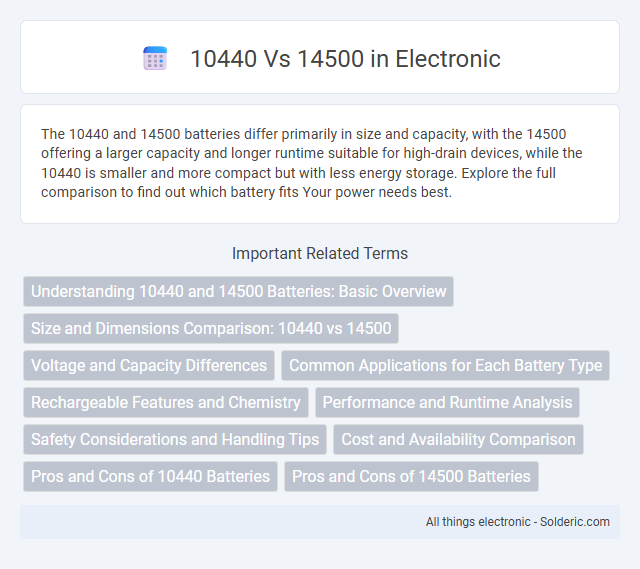The 10440 and 14500 batteries differ primarily in size and capacity, with the 14500 offering a larger capacity and longer runtime suitable for high-drain devices, while the 10440 is smaller and more compact but with less energy storage. Explore the full comparison to find out which battery fits Your power needs best.
Comparison Table
| Feature | 10440 Battery | 14500 Battery |
|---|---|---|
| Size (mm) | 10 x 44 | 14 x 50 |
| Type | Li-ion / Rechargeable | Li-ion / Rechargeable |
| Voltage | 3.7V | 3.7V |
| Capacity (mAh) | 300-350mAh | 600-800mAh |
| Weight | ~12g | ~20-25g |
| Common Uses | Flashlights, Small Electronics | High-Drain Devices, Flashlights |
| Rechargeability | Yes | Yes |
Understanding 10440 and 14500 Batteries: Basic Overview
10440 and 14500 batteries are both lithium-ion rechargeable cells commonly used in small electronic devices, with 10440 batteries typically measuring 10mm in diameter and 44mm in length, and 14500 batteries measuring 14mm in diameter and 50mm in length. The 14500 battery offers higher capacity and voltage output, often around 3.7V and 700-1000mAh, compared to the 10440's 3.7V and approximately 350-400mAh. Due to their size and capacity differences, 14500 batteries are better suited for high-drain devices, while 10440 batteries are ideal for compact gadgets demanding less power.
Size and Dimensions Comparison: 10440 vs 14500
The 10440 battery measures approximately 10mm in diameter and 44mm in length, whereas the 14500 battery is larger, with a diameter of 14mm and a length of 50mm. This size difference affects compatibility, as the 14500 is commonly used in devices designed for AA batteries, while the 10440 fits smaller gadgets requiring a battery similar in size to AAA cells. The increased dimensions of the 14500 accommodate higher capacity and power output compared to the more compact 10440.
Voltage and Capacity Differences
The 10440 battery typically has a nominal voltage of 3.7V and a capacity around 300-350mAh, making it suitable for compact devices requiring high voltage but low capacity. In contrast, the 14500 battery offers a nominal voltage of 3.7V or sometimes 1.5V in alkaline versions, with a significantly higher capacity ranging from 600mAh to 1100mAh, ideal for devices demanding longer run times. Voltage consistency and capacity variance between these two lithium-ion cells impact their suitable applications, with the 14500 providing more energy storage and longer usage per charge.
Common Applications for Each Battery Type
The 10440 battery is commonly used in compact devices such as flashlights, laser pointers, and small electronic gadgets due to its smaller size and higher voltage output. The 14500 battery, similar in size to AA batteries but rechargeable with higher capacity, is frequently utilized in high-drain devices like digital cameras, portable fans, and handheld gaming consoles. Both batteries are favored for their rechargeable capabilities, versatility in portable electronics, and energy density suited to specific device requirements.
Rechargeable Features and Chemistry
The 10440 and 14500 batteries share similar rechargeable features, both primarily utilizing lithium-ion chemistry, which offers high energy density and long cycle life. However, the 14500 typically delivers a higher capacity, around 700-1000mAh compared to the 10440's 300-350mAh, making it more suitable for devices requiring longer runtimes. When selecting between these, your choice should align with your device's size constraints and power demands while benefiting from the rechargeable advantages of lithium-ion technology.
Performance and Runtime Analysis
The 10440 and 14500 lithium-ion batteries differ significantly in performance and runtime, with the 14500 offering a higher capacity typically around 800-1000mAh compared to the 10440's 300-350mAh, resulting in longer battery life for your devices. The 14500 operates at a nominal voltage of 3.7V, providing consistent power output suitable for high-drain applications, whereas the 10440 also maintains 3.7V but with reduced energy storage, leading to shorter runtime. Choosing the 14500 can enhance device performance by delivering extended usage intervals before recharging is necessary.
Safety Considerations and Handling Tips
The 10440 and 14500 lithium-ion batteries differ significantly in capacity and size, impacting their safety profiles and handling requirements. You should handle 10440 batteries with extra caution due to their smaller size and higher risk of overheating or short-circuiting, while 14500 batteries, offering higher capacity, require proper chargers designed for their voltage and size to prevent damage. Always store both types in protective cases, avoid exposure to extreme temperatures, and never mix battery chemistries or brands to ensure optimal safety.
Cost and Availability Comparison
The 10440 battery is generally more affordable and widely available due to its smaller size and common use in flashlights and laser pointers, while the 14500 battery tends to be pricier because it offers higher capacity and voltage suitable for high-drain devices. Your choice might depend on whether you prioritize budget-friendly options or need longer-lasting power, as 14500 batteries often provide better performance but at a higher cost. Both types are relatively easy to find online and in specialty stores, but 10440 batteries are more commonly stocked in general retail outlets.
Pros and Cons of 10440 Batteries
10440 batteries are compact and lightweight, offering high voltage output similar to AA batteries but in a much smaller size, making them ideal for compact electronic devices. Their drawbacks include typically lower capacity and shorter runtime compared to larger cells like 14500, as well as potential overheating risks if used improperly. Despite these limitations, 10440 batteries excel in applications requiring portability and high energy density in a constrained form factor.
Pros and Cons of 14500 Batteries
14500 batteries offer the advantage of a smaller size similar to AA batteries, making them ideal for compact devices, and they typically provide a higher voltage of 3.7V compared to 10440 batteries, resulting in better energy efficiency. However, their capacity is usually lower than some other lithium-ion options, potentially limiting battery life in high-drain devices. Your choice should consider the balance between compact size and power needs to optimize device performance.
10440 vs 14500 Infographic

 solderic.com
solderic.com